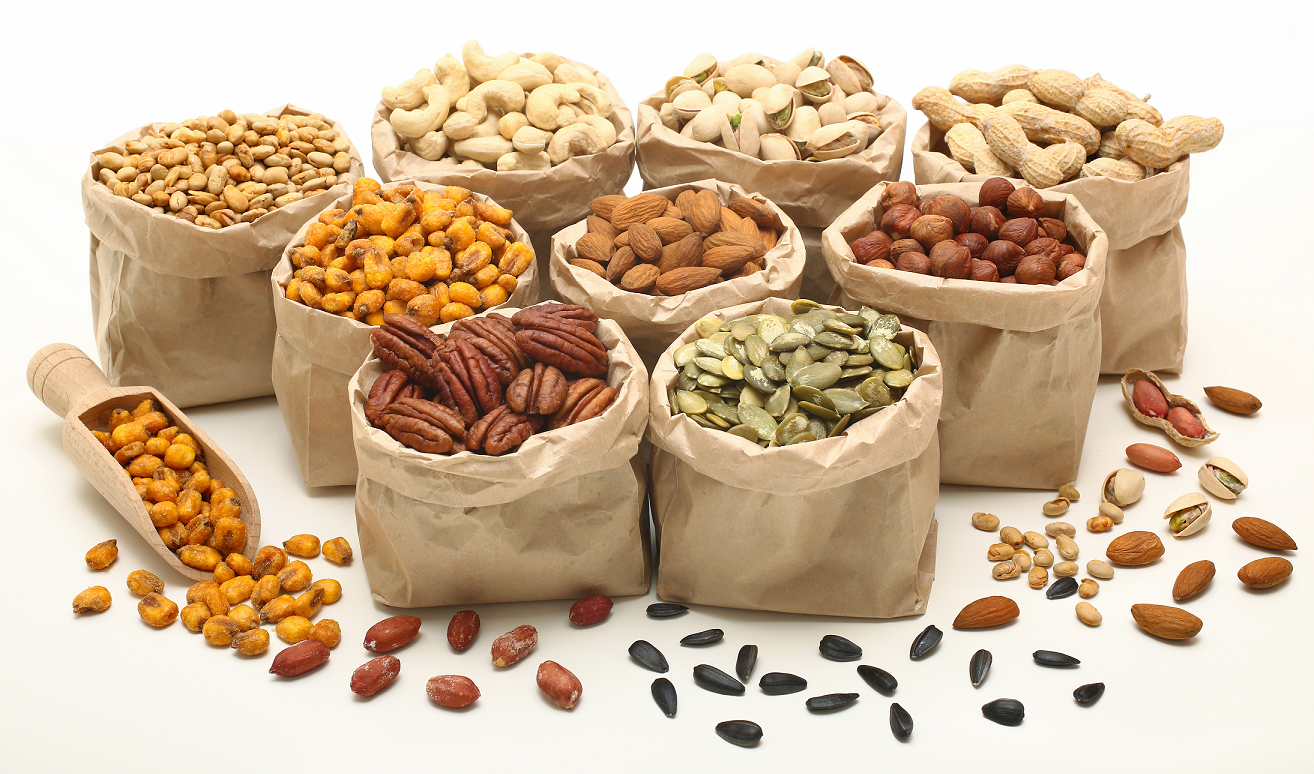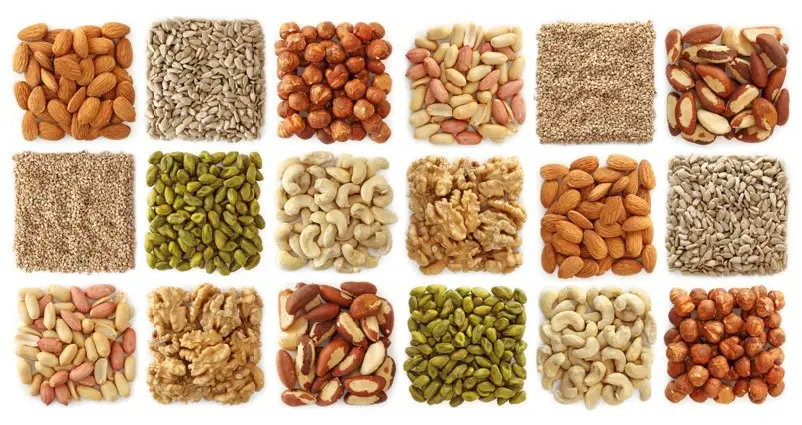16th May 2016
By Katrin Geist
Contributing writer for Wake Up World
Nuts are amazing. Their properties and potential dietary uses has spurred intensive scientific investigation for the past few decades (Russo & Siani 2012). Provided there are no allergies present, incorporating nuts into your diet could be a worth while consideration with a potentially big pay-off.
So – Why Go Nuts?
Sometimes, health solutions are simple and effective healthcare naturally tastes great! Tree nuts represent a dense, highly nutritious source of mostly unsaturated fatty acids (predominantly oleic and linoleic acid) and protein. They also contain a plethora of known health promoting components such as antioxidants (e.g. ellagic acid), flavonoids (e.g. catechins), polyphenols, vitamins, minerals, fiber, and many more (Venkatachalam & Sathe 2006). Together, these constituents turn nuts into a nutritional powerhouse.
Historically, nuts, including their oils and milks, were used to support and improve immunity, digestion, wound healing, circulation, pain relief, colds and phlegmatic disorders, as a diuretic, as a sleeping aid, to treat swollen glands and shingles, and more (Casas-Agustench et al. 2011). Today, known health conditions to benefit from regular nut consumption include heart disease, diabetes, metabolic syndrome, and Alzheimer’s Disease (Alasalvar & Bolling 2015). Nuts also seem to slow the ageing process and may reduce the risk of cancer, asthma, obesity, gallstone disease, inflammatory bowel disease, and inflammatory status in general (Sweazea et al. 2014, Ros 2010).
Nuts owe their beneficial effects to a high antioxidant content, favorable lipid (fat) profile, and low glycemic nature (Alasalvar & Bolling 2015), also making them a suitable snack for diabetics (Cohen & Johnston 2011). The antioxidant efficacy of nuts has been established as follows, in descending order: walnut, cashew, hazelnut, pecan, almond, macademia, pistachio, Brazil nut, peanut* (Vinson & Cai 2012). On a per serving basis (26.8 g), the total antioxidant capacity for nuts ranged from 204 for pine nuts to 5095 for pecans and compares to other high-antioxidant-containing fruit and vegetables: tomatoes (415), beets (1886), cranberry (8983), and blackberry (7701), expressed in Trolox Equivalents (Venkatachalam & Sathe 2006). Note that most antioxidant compounds (90%) reside in the nut skin. Therefore, removing it considerably reduces the antioxidant benefit (Alasalvar & Bolling 2015). (* Technically not a nut but a legume.)
Improved Cognitive Function
The high unsaturated fat content supports brain function by increasing serotonin (a neuro-transmitter molecule thought to play a role in depression) levels and harmonizing cerebral processes (interview with Prof Gerald Huether, German neurobiologist). Despite a lack of clinical intervention trials, observational studies indicate that long-term consumption of even small amounts of nuts may elicit benefits for cognitive function and reduction in cognitive decline (Alasalvar & Bolling 2015, Barbour et al. 2014). Anti-inflammatory medications offer some protection from Alzheimer’s disease, consistent with the hypothesis that damage to brain cells forms part of an overall inflammatory response. If inflammation is the key, then nuts containing anti-inflammatory nutrients, such as polyphenols, vitamin E and omega-3 fatty acids, may prove a very useful tool in reducing damage to the brain (Barbour et al. 2014).
Decreased Inflammation
The high content of phenolic compounds in nuts, particularly in the skin, might anticipate an anti-inflammatory effect of frequent nut consumption, as indeed some studies suggest (Ros 2010). Walnuts in particular may make better anti-inflammatory agents than other nuts, as only they contain substantial amounts of ALA, a fatty acid with higher anti-inflammatory capacity. Walnuts also exhibit high levels of ellagic acid, a phenolic compound with potent anti-inflammatory properties. While more studies are needed to conclusively resolve the question of anti-inflammatory effects of nuts, nut consumption seems to benefit the inflammatory response, as indicated by its decreasing biomarkers in the blood stream (thus suggesting reduced inflammation) (Ros 2010). Epidemiologic studies have suggested an inverse association between nut consumption and inflammation (Falasca, Casari & Maffucci 2014).
Source of Magnesium, Mg
Nuts are an excellent source of magnesium which plays an essential role in various cellular mechansims. Tumor cells frequently show an impaired Mg balance, and Mg deficiency may be associated with inflammation (Falasca, Casari & Maffucci 2014). A recent meta-analysis showed an inverse relationship between magnesium intake and the risk of developing type 2 diabetes. Acute studies revealed that almonds, taken alone or in combination with other carbohydrate-rich foods, can have a similar effect by significantly lowering blood glucose levels and insulin responses after a meal (Kendall et al. 2010).
Improved Endothelial Function
Increased consumption of nuts may improve antioxidant defences and reduce inflammation in populations with increased risk for cardiovascular disease (Alasalvar & Bolling 2015). The results of many epidemiological studies suggest that consuming polyphenol-rich foods shows beneficial effects on a large number of cardiovascular risk factors, including high blood pressure and poor vascular function (Barbour et al. 2014). Food intake affects vascular reactivity. Whether acute or chronic, detrimental effects such as elevated triglycerides (blood lipids) and transient endothelial dysfunction can be counteracted by consuming healthy nutrients: omega-3 poly-unsaturated fatty acids, antioxidants, vitamins, phenolic compounds, and L-arginine (an amino acid), for example, all nut constituents.
L-arginine is a precursor of nitric oxide (NO), a multifunctional molecule modulating vasodilation, and also evoking antioxidative and antiplatelet effects (Venkatachalam & Sathe 2006). Individuals with high blood cholesterol levels show impaired NO synthesis, and supplementation with 7g L-arginine per day has demonstrated benefits, increasing endothelial-dependent dilation by almost 3.5-fold (Barbour et al. 2014). Nuts contain approximately 2g arginine/ 100g, comparable to 2140mg/ 110g of sirloin steak, 2150mg/ 182.55g of whiting fish, and 2140mg of arginine/ 68.39g of peanuts (Venkatachalam & Sathe 2006). Thus, the amount of 30g of nuts per day used in many studies may partly explain the observed improved endothelial function (Barbour et al. 2014).
When endothelial function improves, a lowered blood pressure could be expected as a knock-on effect. While smaller clinical studies did not confirm this prediction, a larger trial showed significant reductions in both systolic and diastolic blood pressure after the nut-supplemented Mediterranean diet compared with the control diet (Ros 2010).
The Physicians’ Health Study reported a 47% reduced risk of sudden cardiac death in subjects who ate nuts two or more times per week compared with those who never or rarely consumed them. The beneficial effect of nuts was independent of age, sex, BMI, alcohol use, or presence of cardiovascular risk factors (Falasca, Casari & Maffucci 2014).
Vitamin E & Nut Oils
Vitamin E functions as a potent antioxidant (see box 5) in cell metabolism, and is thus considered a significant health promoting component of nuts (Alasalvar & Bolling 2015). It may also play a role in lowering inflammation and improving cognitive function (Barbour et al. 2014). Hazelnuts offer higher vitamin E levels compared with other tree nuts. Nut oils also provide an excellent source of vitamin E, with hazelnut containing most, followed by pistachio, almond, pine nut, and peanut oil (Alasalvar & Bolling 2015).
The U.S. Dietary Reference Intake guideline recommends consuming c. 42 g of hazelnuts or almonds per day to achieve an uptake of c.75% and c.73% vitamin E, respectively. In other words, a handful of nuts more or less satisfies our vitamin E requirement (15 mg/ day) (Alasalvar & Bolling 2015).
Cancer Chemopreventive Potential
While recent epidemiological studies confirmed an inverse (beneficial) association between frequent nut consumption and total mortality, other studies suggested that regularly eating nuts could exert a chemopreventive effect, especially on colorectal and prostate cancers (Falasca, Casari & Maffucci 2014).
Nuts contain many bioactive compounds that affect several cellular processes involved in tumor development and progression, such as cell survival, cell proliferation, cell invasion, and angiogenesis (Falasca, Casari & Maffucci 2014). Resveratrol, also present in peanuts, has been extensively studied for its anticancer properties. It not only can inhibit each of the aforementioned stages of cancer development, but also seems able to counteract cancer-related epigenetic alterations (Falasca, Casari & Maffucci 2014).
In their review article Cancer Chemoprevention with Nuts above authors conclude: “The compelling evidence that increased nut consumption is associated with statistically significant reduction of mortality risk, including cancer, suggest that nut consumption should be considered a tool of intervention to reduce the burden of cancer. More importantly, this reinforces the rationale that nuts should be included as a serving in the fruit and vegetables serving recommendation.”
Different Nuttiness Factors
Globally, the most popular and commercially important edible nuts are peanuts and several tree nuts: almond, cashew, Brazil nut, hazelnut, macadamia, pecan, pine nut, pistachio, and walnut (Venkatachalam & Sathe 2006). The following offers more specifics on health benefits associated with some select nuts.
Almonds
Almonds contain fairly high levels of vitamin E and polyphenols, likely conferring this nut its well known antioxidant properties (Sweazea et al 2014). These authors conclude that “almond ingestion, at a typical portion size and without other dietary modification, may be a feasible and effective diet tactic for individuals with type 2 diabetes”, as almonds do not negatively affect blood glucose, oxidative stress, or inflammation. Rather, they lowered biomarkers of inflammation (CRP) by nearly 30% in people with poorly-controlled type 2 diabetes (Sweazea et al 2014). While this looks promising, above study only included 24 participants so that confirmation from larger trials would be desirable. And remember to eat them with skin intact to retain the antioxidant benefit.
Brazil Nuts
These nuts offer a great source of the element Selenium, Se, a mineral required in trace amounts for proper cellular function. Se contributes to the body’s antioxidant systems, immune function, thyroid metabolism, and reproduction. In places like New Zealand with low Se presence in soil and thus produce, eating a few Brazil nuts per week may help compensate this shortfall. Only one kernel (c. 5 g) supplies 174% of the recommended daily Se amount (Alasalvar & Bolling 2015).Selenium has been linked to many health benefits in humans, including decreased risk and incidence of cancer(Falasca, Casari & Maffucci 2014, Freitas-Silva & Venâncio 2011)
Walnuts
Considered one of the oldest tree fruit known to man with records going back as far as 7000 BCE (Casas-Agustench et al. 2011), walnuts exhibit the highest antioxidant and poly-unsaturated fatty acids content of all nuts: linoleic acid (omega-6 fat) and a-linolenic acid (ALA, an omega-3 fat) form the most prominent varieties (Vinson & Cai 2012). These walnut constituents were shown to improve inflammation, arterial compliance, insulin resistance, and endothelial function and blood pressure in clinical and epidemiological studies. ALA is also thought to maintain cognitive function in older adults (Barbour et al. 2014). A whole food in itself, walnuts possess the highest content of ALA of all edible plants and also contain high levels of serotonin. Recently discovered substantial amounts of melatonin in walnuts also contributed a significant antioxidant effect in an experimental rat model (Ros 2010).
A diet with 56g of walnuts added a day improved endothelial function by 45% in participants with type 2 diabetes (Barbour et al. 2014). Another study observed the same effect after a single walnut meal (Ros 2010). A single serving (28.4g) of raw walnuts provides 575mg of polyphenols (antioxidants) which exceeds the daily sum of these antioxidants derived from fruit and vegetables combined (Vinson & Cai 2012).
Pistachios
Native to the Middle East, the pistachio tree is one of the oldest flowering nut trees. Archeological records show that pistachio consumption dates back as far as 7000 B.C. in Turkey – similar to walnuts (Dreher 2012).
Compared to other nuts, pistachios contain less fat and energy, higher levels of fibre, and the highest levels of potassium (K), g-tocopherol, vitamin K, phytosterols, xanthophyll carotenoids, certain minerals (copper, iron, magnesium), vitamin B6, and thiamin. Thus, pistachios exhibit a high antioxidant and anti-inflammatory potential, also ranking in the top 50 foods with a high antioxidant value (Bulló et al. 2015).
Pistachios are the only nut to yield significant amounts of lutein and zeaxanthin (important carotenenoids for healthy vision and prevention of age related macular degeneration, AMD (SanGiovanni et al. 2007)). These carotenoids, polyphenols, and tocopherols are readily bioavailable (ready to use upon ingestion), an important factor when considering a supplement. If the substance of interest is offered in the wrong form, it may go right through you without affecting anything.
Mediterranean diets supplemented with 20–50g walnuts per day and 80–100g pistachios a day improved endothelial function by 21 and 24%, respectively. Pistachio consumption also improved glucose levels, lipid parameters, oxidative status, vascular function, arterial stiffness, and some indices of inflammation that may underlie the observed enhanced endothelial function (Kasliwal et al. 2015, Barbour et al. 2014).
Won’t I Get Fat? What About Nut Allergies?
Evidence from both epidemiological studies and clinical trials suggests that regular nut consumption neither contributes to obesity nor increases the risk of developing diabetes (Ros 2010). On the contrary, they might even decrease body weight (Falasca, Casari & Maffucci 2014). Even though only a secondary outcome measure, most studies examining the effects of nuts on lipid profiles found no negative effects on body weight and showed that nuts – whether almonds, walnuts, pecans, pistachios, or peanuts – improve plasma lipid profiles and can decrease the risk of heart disease (St-Onge 2005). At the population level, multiple reviews revealed that a higher nut consumption consistently translated into a better blood serum lipid profile, and that it may reduce the risk of diabetes, without negatively affecting body weight or body weight gain over time (Russo & Siani 2012).
Nut allergies represent a severe problem for a small fraction of the populace, c. 2% of children and adolescents, tendency apparently increasing, and adults often remain sensitive (Russo & Siani 2012). If you belong to this group, consuming nuts is definitely not part of a healthy diet but unfortunately is best avoided altogether, including hidden nut products in processed foods.
Roasted or Raw? Salted or Plain?
Roasted nuts are delicious. Despite that, I usually prefer raw nuts, as roasted ones show a decreased antioxidant efficacy, (Bulló et al. 2015, Vinson & Cai 2012). I also feel that simple and unprocessed (raw, unsalted) is best, but that’s just a personal preference. There is evidence to the contrary, in that roasting reduces phytic acid levels of nuts, rendering them a more tooth-friendly food than when consumed raw (Nagel 2011).
In regards to salt, here’s what Ros (2010) says: “Nuts possess an optimal nutritional density with respect to healthy minerals, such as calcium, magnesium, and potassium. Like that of most vegetables, the sodium content of raw or roasted but otherwise unprocessed nuts is very low. A high intake of calcium, magnesium and potassium, together with a low sodium intake, is associated with protection against bone demineralization, arterial hypertension, insulin resistance, and overall cardiovascular risk. Obviously, the advantage of the low sodium content of nuts is lost if they are consumed as a salted product.” Barbour et al. (2014) concur.
Conclusion
Growing evidence suggests that nut consumption improves diet quality by providing several bioactive compounds with recognized health benefits. These include glycemic control, cardiovascular health, cancer prevention, improved cognitive function, weight management, and others.
Going nuts seems thus a deliciously good way to support our health. I often enjoy a handful of mixed nuts during the week and find them rather satisfying. They also make a great, energy packed tramping (hiking) snack. Five servings a week (Cohen & Johnston 2011) or 30+g per day should suffice (Barbour et al. 2014). Why not benefit from “possibly one of the most cardioprotective foods in the habitual diet” (Ros 2010)?
So: join me in going nuts, if you so choose! It’s gooood.
For more articles like this, sign up to Holistic Health Global’s monthly Healthy Living Newsletter or like HHG on Facebook!
References:
- Cure Tooth Decay by R Nagel (2011)
- Almond ingestion at mealtime reduces postprandial glycemia and chronic ingestion reduces hemoglobin A1c in individuals with well-controlled type 2 diabetes mellitus
- Cohen AE and CS Johnston (2011)
- Almond supplementation in the absence of dietary advice siginficantly reduces C-reactive protein in subjects with type 2 diabetes
- Sweazea KL, Johnston CS, Ricklefs KD and KN Petersen (2015)
- Brazil nuts: Benefits and risks associated with contamination by fungi and mycotoxins
- Freitas-Silva O and A Venâncio (2011)
- Cancer Chemoprevention With Nuts
- Falasca M, Casari I and T Maffucci (2014)
- Chemical Composition of Selected Edible Nut Seeds
- Venkatachalam M and SK. Sathe (2006)
- Dietary fats, teas, dairy, and nuts: potential functional foods for weight control?
- St-Onge M-P (2005)
- Effect of pistachio nut consumption on endothelial function and arterial stiffness
- Kasliwal RR, Bansal M, Mehrotra R, Yeptho KP and N Trehan (2015)
- Health Benefits of Nut Consumption
- Ros E (2010)
- Health benefits of nuts in prevention and management of diabetes
- Kendall CWC, Esfahani A, Truan J, SrichaikulK and DJA Jenkins (2010 a)
- Mediterranean nuts: origins, ancient medicinal benefits and symbolism
- Casas-Agustench P, Salas-Huetos and JS Salas-Salvado (2011)
- Nut consumption for vascular health and cognitive function
- Barbour JA, Howe PRC, Buckley JD, Bryan J and AM Coates (2014)
- Nutrition attributes and health effects of pistachio nuts
- Bulló M, Juanola-Falgarona M, Hernández-Alonsso P and J Salas-Salvadó (2015)
- Nuts, especially walnuts, have both antioxidant quantity and efficacy and exhibit significant potential health benefits
- Vinson JA and Y Cai (2012)
- Nuts, metabolic syndrome and diabetes
- Kendall CWC, Rosse AR, Esfahani A and DJA Jenkins (2010 b)
- Pistachio nuts: composition and potential health benefits
- Dreher ML (2012)
- The Relationship of Dietary Carotenoid and Vitamin A, E, and C Intake With Age-Related Macular Degeneration in a Case-Control Study
- San Giovanni JP, Chew EY, Clemons TE et al. (2007)
- The role of nuts in the optimal diet: Time for a critical appraisal?
- Russo P and A Siani (2012)
About the author:
Katrin Geist loves exploring the mysteries of life. Initially doing so as a biologist, she now devotes her time to helping people regain and maintain their wellbeing through Reconnective Healing and holistic health coaching. Biophysics taught her the importance and far reaching implications of a truly holistic approach to wellbeing, and to life at large. More and more, she begins to understand how energy, frequency, and information shape our lives – knowingly or not.
Katrin holds a BA from the University of Montana, U.S.A. and an MSc in biology from Berlin University (FU). This science background enables her to communicate scientific subjects in an accessible way, so that everyone can benefit from information otherwise often confined to technical experts.
Katrin has held international wellbeing clinics in several countries and currently works from her New Zealand office in Dunedin. She feel privileged to serve in this capacity and invites you to experience something different. Take back the reins of your health and discover more!
To contact Katrin for personal or remote sessions and to invite her for a seminar or presentation, please call or email her. You can contact Katrin via Facebook • Email • Website • or telephone 0064 (0)21 026 95 806 (NZ mobile).
For more articles like this, sign up to Holistic Health Global’s monthly Healthy Living Newsletter or like HHG on Facebook! You can also connect on YouTube and online at HolisticHealthGlobal.co.nz
Previous articles by Katrin Geist:
- Navigating the Plastic Jungle – Understanding What’s What PLUS Easy Ways to Adjust Your Plastic Use
- Striking the Balance: Why Optimal Body pH Matters and How to Achieve It
- The FAT Facts: Butter vs Margarine
- The Power of Convictions and How They Shape Our Lives
- 10 Significant Reasons Why Regularly Drinking Green Tea Is An Awesome Healthy Living Habit!
- Cradle to Cradle Design – How a Biochemist and an Architect Are Changing the World
- Truly Healing From Cancer and Preventing It Altogether
- How to Lose Your Mind and Create a New One
- Research Shows Promising Effects Treating Advanced Cancer with Light Frequencies
- Depression & Anxiety: Discover 3 Powerful, Drug-Free Ways that Help Thousands, Naturally
- The Power of Suggestion – Are You Asking the Right Questions?

If you've ever found value in our articles, we'd greatly appreciate your support by purchasing Mindful Meditation Techniques for Kids - A Practical Guide for Adults to Empower Kids with the Gift of Inner Peace and Resilience for Life.
In the spirit of mindfulness, we encourage you to choose the paperback version. Delve into its pages away from screen glare and notifications, allowing yourself to fully immerse in the transformative practices within. The physical book enriches the learning process and serves as a tangible commitment to mindfulness, easily shared among family and friends.
Over the past few years, Wake Up World has faced significant online censorship, impacting our financial ability to stay online. Instead of soliciting donations, we're exploring win-win solutions with our readers to remain financially viable. Moving into book publishing, we hope to secure ongoing funds to continue our mission. With over 8,500 articles published in the past 13 years, we are committed to keeping our content free and accessible to everyone, without resorting to a paywall.










